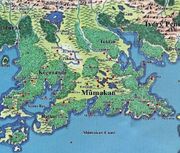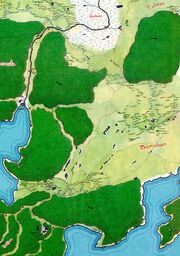
Mûmakan proper
The Mûmakan (Mu. "Land of the Mûmakil") was a large, hilly land best known for it's myriad rivers and jungles. It was situated south of the Tûr Betark and north of the Inner Sea, in southernmost Middle-earth.

Central Mûmakan
Timeline[]
First Age[]
- F.A. 1: The rising of the Sun. Men awaken at Hildorien.
- c. F.A. 150: The first Men migrate into the Utter South. They settle in the region which later becomes the center of Geshân.
- c. F.A. 200: Rise of the Mannish realm of later Geshân under the influence of Avari of the south.
- c. F.A. 400: More Mannish groups, such as the ancestors of the Kîrani, migrate into the Utter South. They live as subjects and pupils of the masters of later Geshân. Their cosmology stems from pre-Geshân teachers, who in turn learned from the Dark Elves.
- c. F.A. 480: The realm of Geshân reaches its cultural and political peak. Their domain encompasses all territories of later Mûmakan. Yet unrest soon reaches Geshân.
- F.A. 501: Beginning of the decline of Geshân. Around this time, the ancestors of the Mûmakani migrate into the Utter South. Their mythology takes on the much darker sides of Geshân religion.
- F.A. 550 - 600: Several catastrophes, such as crop failure, pestilence, civil war, and floods, lead to the final downfall of the realm of Geshân.
- F.A. 603: Morgoth is overthrown, Angband is overthrown, and Beleriand drowned in the distant north. In the greater changes to Middle-earth, the ecological catastrophe causes the final ruin of the remnants of Geshân.
Second Age[]
- c. S.A. 20: The ancestors of the Kîrani begin to organize themselves to a greater degree in the region later known as Kôronânde.
- c. S.A. 40: Arrival of the earliest ancestors of the later Hathorians in the Utter South, believed by some to be kin to the Edain of Beleriand.
- c. S.A. 50: Surviving local priests of the Tyar faith of Geshân who fled their declining realm in the hold of Kírnak teach their knowledge to the ancestors of the Hathorians and Kîrani.
- S.A. 60 - 80: The last priests of the Tyar faith die without successors. Their books of knowledge are lost.
- S.A. 103: the earliest predecessor of later Kôronânde is founded as a united realm.
- S.A. 106: ancestors of the Hathorians are united under a legendary first king, Menes.
- S.A. 353: Sea-faring ancestors of the Ûsakani peoples land for the first time on the western shores of the later bay of Ûsakan.
- c. S.A. 500: Sauron begins to stir again.
- S.A. 972: First landing of Númenóreans at later Kôronânde.
- c. S.A. 1200: Sauron adopts a fair guise as Annatar in the distant north.
- S.A. 1200 - 1300: Frequent raids of proto-Mûmakani armies into the territory of later Kôronânde.
- S.A. 1230: The Great Earthquake. The river Kôros alters its course, leaving later Kôrlan without a port.
- S.A. 1249: The ancestors of the Mûmakani attack later Kôronânde. The siege of the early predecessor of Kôrlan takes place, but relief is provided by a Númenórean force.
- S.A. 1253 - 1260: The port of later Kôrlan is rebuilt with Númenórean aid. Long walls between the old city and the new port are built to protect the ancestors of the Kîrani from their aggressive neighbors.
- S.A. 1276: Despite proto-Ûsakani resistance, the Númenórean colony of Lond Hallacar (later Sarûl) is founded along the jungle-infested northeastern coast of the Bay of Ûsakan.
- S.A. 1600: The One Ring is completed.
- S.A. 1701: Sauron is defeated by Númenóreans and the Elves of Lindon in the War of the Elves and Sauron.
- c. S.A. 1750: Sauron's agents enter later Mûmakan and begin influencing the Shaman-lords in the land of the Mûmakil.
- c. S.A. 1850: Under Tar-Ciryatan, military concessions are exacted from the people of Middle-earth. Lond Hallacar grows rapidly, with many ships going there instead of to later Kôrlan.
Regions[]
Amba Mûdaka jungle Bay of Kôros Coast of Mûmakan eastern hill-country Kann-Shamurda plateau Lakes of Kann-Sharmûnda Mîmakai hills northern hill-country southeast cape southern rainforest southern savannas southern shores of the Bay of Gan
Places of Note[]

Amarû Aurax-Dûr Batamak Dûrdamal Dûrlam Engkîr Jessa Lond Hallacar Mamûri Mirisgroth Mûmarak Nûlakad Pharabâs Tanith Tauronde Tirgoroth Tombs of Oran-Plaar Ûmakad
Characters[]
Inhabitants (of Greater Mûmakan)[]
Dwarves:
Elves:
Giants:
Men:
- Black Númenóreans
- Chaialla
- Gânim
- Hathorians
- Kîrani
- Mountainmen of the Tûr Betark
- Mûlambûri
- Mûmakani
- Sâre
- Sharaeki
- Tantûraki
- Tûktani
- Ûsakani
- Yatali-Gan
- Woodmen of the utter South
Orcs:
Trolls:
Lore[]
The vast elevated plain of central Mûmakan was a savanna, the outskirts of which were punctuated by irregular rocky hills. The northern half of the plain was dominated by the Kann-Shamûrda, a collection of vast lakes.The Mûmakanda uplands descended into small coastal plains covered with dense tropical rainforest. The climate of the whole region was subtropical and dry, making it a suitable home for lions, leopards, jackals, rhinos, giraffes, zebras, antelopes and, of course, the huge Mûmakil from which the land derived its name. Twelve tribes made up the Mûmakani, each of which consisted of a number of clans. The twelve tribes were further grouped according to the kind of environment they typically lived in (which led to shared life-ways and a strong feeling of unity). The largest and most traditional tribal grouping were the Zamaril, semi-nomadic savanna-dwellers. The second group, the Krâlakril, lived in or near the borders of the rainforests. Though fewer than the Zamaril, the Krâlakril lived in more populous settlements, supported by great numbers of slaves who cultivate food as well as cash crops (e.g., Fuglas and fruit) for the warrior class. The third group of tribes were the Sîril, who lived near the coasts. A bit more civilized than their kinsfolk, the Sîril often acted as traders with neighboring peoples, though most lived by fishing and hunting.
References[]
- the Wild Lands south and East, Gazetteer by Pete Fenlon
